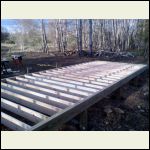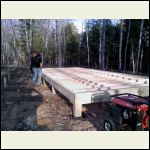|
| Author |
Message |
dusty46
Member
|
# Posted: 10 Sep 2013 02:49am
Reply
Is it better to install floor joist on top of beams or in between beams flush. Building 16 x 26 cabin
|
|
OwenChristensen
Member
|
# Posted: 10 Sep 2013 07:10am
Reply
In my book, on top with ten to twelve inches overhang.
|
|
Martian
Member
|
# Posted: 10 Sep 2013 08:31am - Edited by: Martian
Reply
I've done it both ways, and they both work. My preference is to place them between the beams because it is simpler to skirt the crawl space, and you can keep the cabin lower.
I'm building a 16X32 MIL cabin now. Because there will be a ramp instead of steps, every inch lower saves a foot of ramp; so I'm definitely putting the joists inside. My process is to put on the first layer of banding, fit the joist, and run two 4" screws into each end. Then I come back with the second layer of banding, and run 6" flange-headed screws into the piers, and into the center joist of each section between piers. After all the banding is in place, I go back and put the joist hangers on with 3" screws to capture both layers of banding at each joist. I use 4" clamps, top and bottom, to hold everything tightly together before running in the screws. That way, everything is tied together quite nicely, and there are no visible fasteners, except the flange screws, and they are squared and aligned with each other for appearance.
If your beams are below the joist, you have access to underneath only from the ends. That can make plumbing a little more difficult if its close to the ground.
But, Owen's way works, too, and it makes it easier to build a square structure.  With the beams on the outside, you have to make sure you keep the beam straight. With the beams on the outside, you have to make sure you keep the beam straight.
Tom
|
|
dusty46
Member
|
# Posted: 10 Sep 2013 08:40am
Reply
Thank you soo much the height issue is a concern I want to make it as low as possible. But can I attach 2x8 joist to 6x6 beams. Between the beams?
|
|
Martian
Member
|
# Posted: 10 Sep 2013 08:50am - Edited by: Martian
Reply
6x6 beams? Why? That requires your piers to be quite close together. 2X8 joist won't span a 16' structure without a center beam. I'm using 2X12 treated for the beams which sit on notched 6X6 piers, and 2X10 joist on 16" centers to eliminate the center beam.
Tom
|
|
dusty46
Member
|
# Posted: 10 Sep 2013 09:02am
Reply
Would the 2 x8 joist be solid. Could I make a beam with 2 or 3 2x8 to attach the joist to. Reducing the number of piers would be nice my original plan was to use 12 beams with the 6x6. 4 each one on the ends and one down the center. Is this overkill
|
|
dusty46
Member
|
# Posted: 10 Sep 2013 09:03am
Reply
I meant 12 piers not beams. I would use 3 beams
|
|
Martian
Member
|
# Posted: 10 Sep 2013 09:09am
Reply
You can triple up 2X8's, or go to a wider beam board and only double them. I do the 2X12's because it gives me a cleaner look, and allows for easier installation of skirting. There are calculators you can use to determine the pier spacing for a given beam...Google it.
I gotta run. Good luck.
Tom
|
|
|
rockies
Member
|
# Posted: 10 Sep 2013 08:34pm
Reply
A problem a lot of people have with a floor built on piers is that a very large surface becomes exposed to the cold weather (the underside). Most people stuff the floor full of batt insulation and then put on a plywood sub-floor, but this can create the same sort of problems as an unvented roof. Condensation can get trapped in the cavity and condense on the inside of the bottom plywood causing mold and rot. You might want to use a spray foam like "Tiger Foam" to seal around the rim joists and butter the bottom layer of plywood before putting in the batt insulation. This helps raise the surface temperature of the plywood and also creates a vapour/air barrier seal. After many attempts at finding a better way I finally decided to use a 10 inch SIP for the floor on top of perimeter beams and piers and then install the doors and windows 6 inches higher than normal to allow me to build a 6 inch deep false floor. All the plumbing and wiring can be run under the false floor, and since they are now inside the warm zone they won't freeze or interfere with the insulation.
|
|
MtnDon
Member
|
# Posted: 10 Sep 2013 09:15pm
Reply
Quoting: rockies Most people stuff the floor full of batt insulation and then put on a plywood sub-floor, but this can create the same sort of problems as an unvented roof.
I disagree with that theory.
If that was true then why do we not vent walls?
We vent attics and cathedral ceilings because warm air rises and contains water vapor. That moisture laden warm air finds its way through air-leaky ceilings into the cold attic or cathedral ceiling space. There it condenses on the underside of the cold roof sheathing. Therefore a standard / traditional attic or cathedral ceiling needs a wash of fresh outdoors air to remove the moisture laden air.
The same does not apply to floors. Most mold or mildew I've under a floor has been caused not by moisture in the insulated floor joist space*, but but moisture trapped in an improperly ventilated crawl space, or a poorly designed or poorly vented crawl space. IE, one without any ground cover moisture barrier and too few or no vent area.
* Except for cases where leaky plumbing has caused moisture to be trapped in the floor joist area.
A SIP base floor with a conditioned false raised floor for utilities would be a very nice floor, especially warm in winter, but beyond the budget of most cabin builders, IMO. Plumbing leaks in a floor like that could still be a potential problem source.
In the typical raised floor in a cabin, the plywood or OSB subfloor acts as a vapor barrier for the floor. The exterior grade glues have a rating of one perm or less. That means you can use unfaced batts. If faced batts are used the face goes up against the subfloor.
Anyhow that is how I see it; something to think over before getting overly worried about the use of batts in floor joist bays.
|
|
TheCabinCalls
Member
|
# Posted: 10 Sep 2013 10:30pm
Reply
I agree that these are two different animals. However, it is not just warm air. It is also the radiant heat of the sun hitting the roof. With a floor we are trying to prevent a smaller heat source from transferring out of the floor. There is no real trapped heat like the sun's heat in the attic space.
That said there's a lot of bridging and therefore transfer of heat from a building exposed like this. If it is really the goal to stop thermal bridging there is a lot involved.
Main goal is to make sure moisture is escaping in the right direction if you insulate for the bare minimum.
|
|
larry
Member
|
# Posted: 11 Sep 2013 10:56pm
Reply
i went inside using Simpson strong ties joist hangers.
0508091938.jpg
| 
0508091939.jpg
|  |  |
|
|
dusty46
Member
|
# Posted: 11 Sep 2013 11:04pm
Reply
Thanks for the pictures what size is your building. What size lumber did you use for joist and beams. Did you use treated for all of it
|
|
dusty46
Member
|
# Posted: 11 Sep 2013 11:05pm
Reply
How far apart are your support piers
|
|
dusty46
Member
|
# Posted: 11 Sep 2013 11:06pm
Reply
Thanks for the pics
|
|
|

